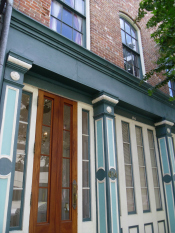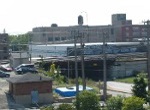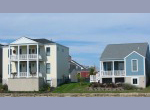Mixed-Use Development Delivers Multiple Community Benefits
Last Updated: June 16, 2024
Mixed-use development means that a building or complex includes a mixture of land uses. Typically, the term is used when residential uses are combined with office, retail, entertainment, child care, or civic uses such as libraries, government or non-profit organization offices.
Mixed-use zoning districts may be huge in scale, or they might be confined to one small site. A common pattern (shown on this page) consists of sidewalk-level storefronts or restaurants with apartments on the second and third levels. These developments may be said to be vertical, meaning that uses vary from one floor to another in a building, as in our example.
At other times, the mixture is horizontal, which might mean side-by-side storefront bays in the same building include two different uses, such as office and retail. It might mean a complex of buildings in which each building may include only one use. For example, a typical block of condo buildings might end with a building consisting of small storefronts. Or whole residential blocks might be interspersed with commercial or office development.

Usually, some land uses are prohibited in a mixed-use zoning district,
so "mixed-use" doesn't mean "any use." Typically prohibited
are drive-through restaurants, service stations, dry cleaners, and other automobile-intensive
or chemical-driven businesses.
Benefits of a Mixed-Use Style of Real Estate Development
Four groups experience the advantages of mixing land uses:
1. The community at large
2. Residents of the development
3. The local government
4. Developers
Communities appreciate mixed-use development because the compact, efficient land use pattern offers residents an excellent opportunity for short commutes to work, convenience shopping, restaurants, and gathering places.
The resulting increase in walking, and decrease in short trips by automobile, benefits individual health, increases the sense of community, and reduces traffic congestion and energy consumption for transportation.
A well-designed mixed-use development consisting of more than one building also lends itself to "placemaking," the art of creating a real sense of place distinctive to a site or community. Unique spaces may lend beauty and enhance market demand for both housing and commercial space.
Cultivating such developments also enables progress toward the often-stated but little-realized community goal of more affordable housing, since low-income housing and multi-family housing in general can be sited on the upper stories of commercial buildings with little or no outcry from the neighbors. Thoughtful designers can manage to tuck in some highly affordable housing units that benefit both future residents and the community.
Mixed-use also can assist in meeting environmental sustainability goals. This tool can be a powerful antidote to sprawl. If you're an activist or local government official who has become interested in mixed-use primarily for this reason, you will need to understand that problem thoroughly and imagine how a development proposal can promote compact development. Explore the suburban sprawl section of this website at length. A book we like is Smart Growth in a Changing World; ask your library to find it for you.
Another advantage of vertical mixing to the community is that it allows greater intensity of land use in desirable locations, such as near downtowns, research hubs or innovation districts LINK, cultural centers, transit stations, or universities.
After all, one of the big advantages of mixed-use development is reduced automobile use. As would be evident right away to traffic engineers, "internal capture," defined as trips from Point A to Point B all within one project, is higher for mixed-use development. This leads to fewer demands on local government for traffic mitigation, including repairing potholes, repaving, or constructing new road lanes and other expensive capital improvements.
Many of the benefits of mixed-use development for its future residents already should be apparent. The buyers or renters attracted to such developments appreciate the convenience of living close to restaurants, bars, the gym, convenience shopping, co-working spaces, and maybe even their workplace or a transit line. Both millennials and empty nesters seem especially prone to placing a high priority on walkability, but 2020 National Association of Realtors research shows a majority of all age groups want to walk to important destinations. Ease, convenience, and instant gratification are strong motivators in some segments of today’s housing market.
Residents most frequently mention three other benefits:
- Many younger people especially deliberately choose quirky locally owned businesses over chain stores when there is a reasonable choice. Specialty shops, and particularly gathering spaces such as smoothie bars and coffee shops, can thrive with built-in traffic from nearby residents.
- The coronavirus pandemic accelerated the technology-fueled trend toward working remotely from home, and when public health considerations ease a bit, the new freedom from a required office location spills over into a lifestyle preference for more working from an expedient gathering space or designated co-working space.
- They want to experience the interesting and challenging joys of living in a community where neighbor interaction is nearly inevitable. and experience the interesting and challenging joys of living in a community where neighbor interaction is nearly inevitable. Ease and convenience are strong motivators in today’s housing market.
For the municipality, adding commercial space to a residential development offers the prospect of enhanced sales and property tax bases. Importantly, the government and any private utilities involved can realize major savings on capital investments in roads, sewers, water and electrical lines, and telecommunications infrastructure, when compared to accommodating the same population in large lot, suburban style single-family homes. Maintenance and future replacement also are simplified and therefore less expensive.
Lastly, advantages to developers may be somewhat less obvious. Change is hard for them too, and if they sense that the city is unsure of how to process a mixed-use proposal, that will deter some risk averse developers.
But developers who read about walkability preferences in the National Association of Realtors survey will realize that well executed mixed-use is quite attractive to the market. Residents enjoy the lively street scene, and business tenants appreciate built-in foot traffic, repeat customers, and the potentially significant benefits of “eyes on the street” protection against crime and vandalism as residents walk, run, and walk their dogs. Business owners also will enjoy the potential to live near their work or take a customer or supplier to lunch nearby.
Economically, tenant attraction and retention may be easier than in single-purpose developments. Developers also diversify their income streams and spread the risks by including more than one type of land use at a single location.
Why the Resurgence of Mixed Land Use Patterns?
We suspect that the current slow trend toward more mixing of land uses has several sources. Traffic in both large and small cities became untenable, and people tired of commuting to work and finding even a drive to the grocery store to be frustrating and time-consuming.
A younger generation began to exhibit much less enthusiasm for driving, and more excitement about working and meeting other young people in coffee shops. Eating out has replaced a number of home-cooked meals during the week, and eating out at breakfast in particular has become dramatically more common.
But we think mixed use development was given a huge boost by the emergence of the broader concept of new urbanism.
New urbanism arose in the 1980s as a trend to revive the traditional neighborhood, which often included live-work units in which families lived above the store. While this idea seemed new-fangled when it was introduced, this was the historical pattern in cities. When the annoyances of driving everywhere through a boring cityscape built, the time was right or rediscovering the joys of walking to the corner store or taking the elevator down to convenience shopping or a favorite restaurant or bar.
But there was a problem. Early in the renewed popularity of the mixed-use concept in America, the financial industry didn't know how to lend for these developments. Mixed-use development did not meet the lending community's standard list of product types. Lenders feared that one or another of the land or building uses would become obsolete or suffer reduced market demand. Because of this lender reluctance, mixed-use development usually required a public-private partnership, with public sector financial participation or guarantees.
The financing problem is really easing in the last few years as the real estate service industries have recognized the undeniable shifts in resident and business tenant preferences.
Mixed use proponents now have made great strides in overcoming another problem, namely the inability of city planning and zoning laws to provide a clear pathway to approval of such developments. Those processes are the topic of the next section.
Mechanics of Zoning and Plan Review for Mixed Developments
In contrast to European central cities, where mixed use never went out of style, in many communities in the U.S. mixed-use developments were literally illegal until recently. Keep in mind that almost no U.S. zoning ordinance as recently as the 1980s allowed this type of development, but most now have provided some route to accomplishing the goal. We suspect a few towns still haven't changed their zoning ordinance.
Before launching into some details, we should emphasize that the very best accommodation for multi-use developments is probably a carefully done form-based code. These codes replace all or part of traditional zoning and cause all the complications described in the next few paragraphs to become moot. Check to see if this option is right for your city.
But if a form-based code isn’t feasible for you today, we have some recommendations about how to bend your familiar frameworks to allow more mixed developments.
A traditional zoning ordinance lays out land uses that are permitted on each parcel of land, not allowing for both residential and commercial in one building or even one block. The trend is definitely toward correcting that problem, but many cities have taken months to deliberate about how to approach mixed use development.
Often municipalities permitting mixed-use development have a special mixed-use zoning district (typically called MXD), or alternatively a zoning overlay district, which means an additional set of rules "overlaid" on all or part of an already existing zoning classification.
As an interim solution, some cities, counties, or townships simply allow applicants to manipulate an existing planned development, planned unit development (PUD), or planned community designation in the zoning ordinance to fit their mixed-use project.
We think that a mixed-use zoning district, which may have very complex regulations, actually is preferable public policy to relying solely on a highly discretionary review process under a planned unit development (PUD) or special use permit process.
However, our best advice is to combine both things—that is, allow mixed-use development only in an MXD zoning district, but also require a criterion-based site plan review, similar to that used to evaluate planned developments.
Remember that you can use the site plan review to allow a relaxation of standards, in addition to imposing requirements. For example, many ordinances use the commercial setback requirements for all buildings within the mixed-use development, but sometimes using the commercial setback won't make sense for all parts of a development. This is where your flexible site plan review process should overrule the strict application of the setback when it doesn’t make sense.
Adjusting the parking requirements is a related problem. Shared parking is quite appropriate in a mixed-use situation, but often municipalities are stuck in adding up parking requirements for each type of land use instead of recognizing real-life parking patterns and needs. This could involve assessing automobile usage, automobile ownership, and parking needs at various times of the day, week, and year.
Occasionally the interpretation of the building code also becomes a problem in mixed-use buildings. For example, commercial buildings require sprinkler systems, but must that extend to the residential area as well? For municipalities that adopt the latest versions of standard codes, those bases are covered, but others may have to grapple with such issues.
Finally,
cities should give some weight to the burden on developers of a greater level
of discretionary scrutiny than they would undergo if they built within the
provisions of a traditional multi-family or single-family zoning district.
Developers experience both inconvenience and financing costs associated with
longer review. In some cities and states, developers will complain with some
justification that the uncertainty of long review makes it difficult for
developers to assert that their development rights have "vested,"
which is an important legal or financial concept in some states. (A vested
right is a reasonable expectation that a developer will be able to follow his
or her plans.)
How Towns Can Encourage Mixed-Use Development
By now it should be evident that municipalities that want to promote mixed-use developments need to be proactive and address zoning, parking, land use planning, and planned unit development provisions before a developer is knocking on the door. Better decisions are likely when a particular development proposal is not literally awaiting your action.
If you really want mixed-use development, develop charts, diagrams, computer sketches, or renderings to illustrate your intent. This could be one set of master drawings and diagrams for all mixed-use projects in the community, but you may want to develop a set of illustrations for each large MXD district.
Incidentally, make sure you have buy-in from all or nearly all planning commissioners and city council persons. We can't mention often enough the value of taking your decision makers on a field trip to a neighboring community where one or more samples of a working multi-use building or development can be toured.
Then invite residential and commercial developers to meet and mingle, because in some communities, those are two different camps who aren't well acquainted with one another. While you're planning a meet and greet event, also invite some lenders who appreciate the concept and a few others who are skeptics.
Make sure any design standards or guidelines that you want enforced in your community are in place. Any absences or loopholes in your design review process will be exploited by an unscrupulous or just less than artful developer. And if you're in a community with no formal design review, you might want to consider enacting a process requiring at least some level of design scrutiny before entertaining proposals for mixed-use developments.
MXD Zoning in Redevelopment
Consider mixed-used development especially when you are faced with a large parcel of land that becomes vacant. This might be a former manufacturing plant, closed shopping center, shuttered military facility or college, or other large parcel that somehow needs to be revitalized.
Candidate locations for a successful mixed use include entire block faces where commercial or office uses would be viable, prominent corner locations where a parcel large enough for at least one floor each of commercial and residential development is available, and areas near large activity generators.
No matter how much you love the multiple land use pattern, and we are definitely fans, don't start applying it willy-nilly to any vacant lot where a property owner smells a higher valuation if the zoning is called mixed-use.
Just because you assign a mixed-use zoning classification, or an overlay zoning district permitting mixed-use development, don't go crazy about modifying height and lot coverage requirements. Building scale and building massing still matter—a lot. Don't show us a four-story mixed-use building in the middle of a block of nice story-and-a-half homes and be all proud of yourself because you have embraced such a progressive concept.
If you are marketing a large site for redevelopment, emphasize its distinctive properties in your communications with prospective developers and lenders. For instance, if it is near a university, you may want to emphasize research facilities, artist space, and student housing along with a more typical mix of residential, office, neighborhood retail, and a couple of restaurants.
Are Development Incentives Needed?
You also may find it necessary to offer economic development incentive tools, subsidies for affordable housing, or incentive zoning granting density bonuses or increases in floor area ratio, to developers who provide certain amenities. For example, keeping housing at a certain affordability level could make the development eligible for a greater density than would otherwise be allowed.
You might ask why you should consider any public sector financial incentives, such as tax increment financing, if mixed-use development is so desirable. After all, renter acceptance of mixed-use residential units generally has been positive, as long as automobiles are accommodated in some fashion.
There are four reasons to consider an appropriately-sized public sector financial incentive:
1. Developers tend to avoid what they see as the risk in trying new types of projects, and they may need a nudge in the right direction.
2. Mixed-use projects usually require more complex and lengthy administrative approvals, and lenders may graciously pile on another layer of red tape if a developer wants to do something slightly unconventional.
3. Your site may be in an area ripe for redevelopment or at least an upgrade that the privte market does not seem to address.
4. There ais a truly realistic gap between the developer’s income and expense projections.
Note that these last two reasons are the same as for any TIF deal!
For neighborhood or community organizations, your local government might have to assist if you really want to meet the community’s goals for the project. If you want to ensure that the existing community around the proposed site reaps some of the benefits of the new investment and avoids harmful displacement resulting from gentrification, consider advocating tirelessly for a community benefits agreement.
If you feel your community is desirable enough that you shouldn't have to offer incentives, first try education and lots of it. If one or two developers aren't receptive, keep looking and talking to prospects. Eventually you'll find one who's interested in applying the concept to your situation, and then you can explore the logistical complications and finances of the potential new construction.
Design Tips for Successful Mixed-Use Development
1. We shouldn't have to say this, but if you're approving a mixed-use development to attempt to create a compact development pattern, reduce traffic, and relieve congestion, then of course it needs great sidewalks or even better, a multi-use path system. Make the paths and promenades as convenient and comfortable as possible, and if that means diagonal paths, that's fine. Connect with adjoining properties also, when possible, for a truly walkable community and a bikeable environment as well.
2. In most locations other than the regional shopping mall, two or three stories of retail won't be successful, but one story of shopping with several floors of condos or apartments above may be highly desirable in the right neighborhood.
3. Some variety of building heights and mass in a multi-structure mixed-use development is essential. Four identical four-story buildings won't seem appealing in most cases.
4. Facades of buildings used commercially on the first floor need higher ceilings on the first floor, and also a high degree of articulation (recesses, protrusions, large windows, and design features) to define it as a commercial space.
5. Live/work units are common features of mixed-use developments. The term is typically applied to a multi-story vertical unit with commercial occupancy on the ground floor and usually a single residential unit for the business owner on upper stories. In some locations they are allowed to be rented out separately, but this arrangement often leads to difficulties with stairways, privacy, soundproofing, firewalls, and ventilation.
6. Try to avoid obvious mistakes. For example, a couple of us toured a project in which an architectural firm was the culprit. They didn't plan sufficient depth for the storefronts on the first floor, so they were never very attractive to retail tenants. Residents didn't want to live on the first floor adjacent to the sidewalk, so the end result was a vacant ground floor, which discouraged both residential and retail tenants and negated the value of the multi-use approach.
7. Don't skimp on landscaping and tree canopy. If the tract is large, a project of course should contain some open space and natural amenities. Retaining all your stormwater on site, required many places, will give you a good start on a potentially attractive open space.
8. Be sure to play up any transit access available at your site. If you're near a transit station, you may want to house a park-and-ride lot during the day if you feel you can build restaurants and attractive night life to retain people in your neighborhood after hours. Explore the whole idea of transit oriented development (TOD) and transit-adjacent development in depth.
Related Land Development Concepts
As just mentioned, mixed-use may be related to new urbanism or transit-oriented development (TOD) in some people's minds. New urbanism certainly supports a mixed-use concept, but there are other mixed-use buildings and developments that don't embrace the entire theory of new urbanism. And a transit-oriented development could be all commercial or all residential, although many current examples are indeed mixed-use.
The smart growth movement also touts mixed-use development, because it lends itself to compact urban form, but in theory, a mixed-use development could thrive as a leapfrog development a considerable distance from the city center. Just be careful about assuming that interwoven land uses automatically means there is no sprawl.
Lastly, beware too of claims that this development pattern automatically meets your community standards for environmental sustainability. It is helpful to develop a matrix of how each use will relate to the others. For example, putting a bowling alley in the basement of an office building is not what we’re talking about here. Some synergy among uses is necessary to make a successful project, and that compatibility should be reflected in the form of decreased transportation costs and increased social interaction and social mobility opportunity.
For More Considerations on Related Topics See These Pages
- Making and Keeping a Good Community >
- Zoning and Codes > Mixed-Use Development
Join GOOD COMMUNITY PLUS, which provides you monthly with short features or tips about timely topics for neighborhoods, towns and cities, community organizations, and rural or small town environments. Unsubscribe any time. Give it a try.




